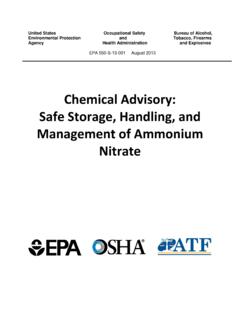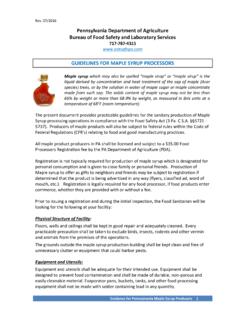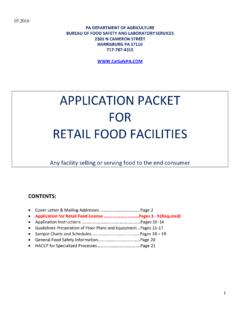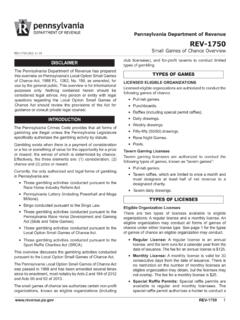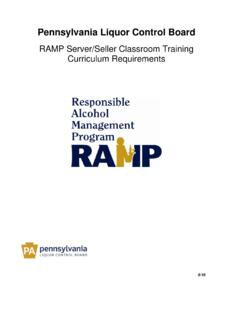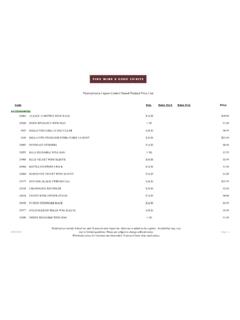Transcription of Kombucha Brewing & Bottling Guidelines
1 05/2017 Kombucha Brewing and Bottling Guidelines 1 Pennsylvania Department of Agriculture Bureau of Food Safety and Laboratory Services 717-787-4315 Kombucha Brewing & Bottling Guidelines -- Hazard Concerns & Preventive Controls for Safety -- DEFINITION Kombucha is a fermented beverage made from brewed tea and sugar. The Kombucha process resembles Vinegar fermentation. Like vinegar, Kombucha is a yeast fermentation of sugar to alcohol followed by a bacterial fermentation of alcohol to acetic acid.
2 The symbiotic culture forms a pellicle or biofilm on the surface of the brew often called a mushroom or SCOBY "Symbiotic Colony of Bacteria and Yeast" which can be reused for subsequent batches. Alcohol and acetic acid content of Kombucha is less than 1%, respectively, but can rise to 3% during a long ferment. This is a unique process where a double fermentation takes place; thus, more preventive process controls must be established to ensure food safety of the finished product. PROCESS FLOW Generally, the process includes infusing tea leaves into freshly boiled water.
3 Sugar is added at 5% to 15%. The tea is allowed to brew for approximately 10 minutes and the tea leaves are removed. The tea is cooled to room temperature and approximately 10% of fresh-fermented Kombucha containing the microbial mat from a previous batch is added to the sweetened tea. It is then covered with a clean porous cloth and incubated at room temperature (60-70 F) for about 7 10 days. If the fermentation continues beyond 10 days, acidity may rise to levels potentially harmful to consumers (equivalent to drinking undiluted vinegar).
4 RETAIL FOOD FACILITY & FOOD ESTABLISHMENT REQUIREMENTS Production of Kombucha in a licensed retail food facility is considered a Specialized Process under the Food Code, and requires a HACCP plan. HACCP plans should be submitted to your Inspector and approved prior to conducting the specialized process. Production of Kombucha tea in a food establishment or limited food establishment will require registration and inspection. The process does NOT require a formal HACCP plan, although all food processors are responsible for understanding the food safety preventive controls necessary in the production of their food products, and subsequently maintaining the associated records to document adherence to the identified preventive controls.
5 05/2017 Kombucha Brewing and Bottling Guidelines 2 HAZARDS ASSOCIATED WITH Kombucha & IDENTIFIED PREVENTIVE CONTROLS FOR SAFETY BIOLOGICAL: The intent of a fermentation process is to achieve a final pH < ; thus producing a non-TCS food (Time Temperature control for Safety Food) - a food that does not require temperature control to mitigate growth of pathogenic microorganisms. Producers of acidified/fermented foods or beverages will be approved only if testing results for equilibrium pH show that their products fall within safe ranges of pH or below.
6 However, producers of unpasteurized bottled Kombucha or any other fermented beverage should aim for a pH level of or below. Since Kombucha starts with an approximate pH of 5 and finishes with a pH < this step of the process would require food safety monitoring of pH as a preventive control to ensure safety. o Use boiling water to steep tea (to kill non-beneficial / undesired microorganisms). o Use only clean and sanitary equipment and utensils and adhere to good manufacturing and personal hygiene practices (to prevent cross-contamination).
7 O Use a commercially purchased culture on the first use. Reuse only culture from Kombucha that shows no signs of mold or unusual contamination. o The pH of fermenting Kombucha shall be monitored using a calibrated digital pH meter. o The food safety threshold for pH is If the pH is still > , continue fermenting and re-measure. If the pH does not reach pH in seven days, discard all Kombucha and start a new batch with preferably a newly purchased commercial culture. o Discard all Kombucha that is showing signs of mold contamination.
8 Do not reuse for inoculum. CHEMICAL: 1. Acidosis: Excessive consumption of Kombucha may have toxic effects due to possible acidosis which could lead to serious health problems especially in individuals with preexisting health conditions. o Generally, the Kombucha operational target for pH is , and the pH will continue to lower as the Kombucha is allowed to continue fermenting. pH must be measured until the time of sale/serving or Bottling . pH below is unsafe for consumption. o Kombucha with a pH below or that tastes especially acidic should not be offered to consumers.
9 A fresh brewed tea or distilled water can be used to dilute the high acidity until pH is greater than , but should never be higher than pH o Consumer warnings: Consumers should be notified that no more than 4 oz. per day is recommended and that immunocompromised individuals should avoid consuming. Furthermore, they should be made aware that minor amounts of alcohol may be present. o Using health claims on the label is not legal ( drinking Kombucha will cure some ailment).
10 05/2017 Kombucha Brewing and Bottling Guidelines 3 2. Alcohol Toxicity (Specific Gravity Level): Kombucha in unpackaged form will typically have an alcohol content <1%; however if there are problems with the symbiotic nature of the culture, the Kombucha ferments for extended times beyond the typical 10 days, or the Kombucha is placed into tightly covered buckets or containers, the alcohol content may continue to rise. Alcohol in bottled or canned unpasteurized Kombucha will most likely exceed , as the beverage continues to ferment, even slowly.






